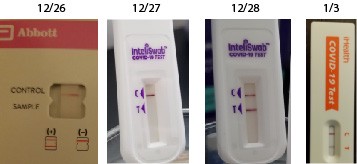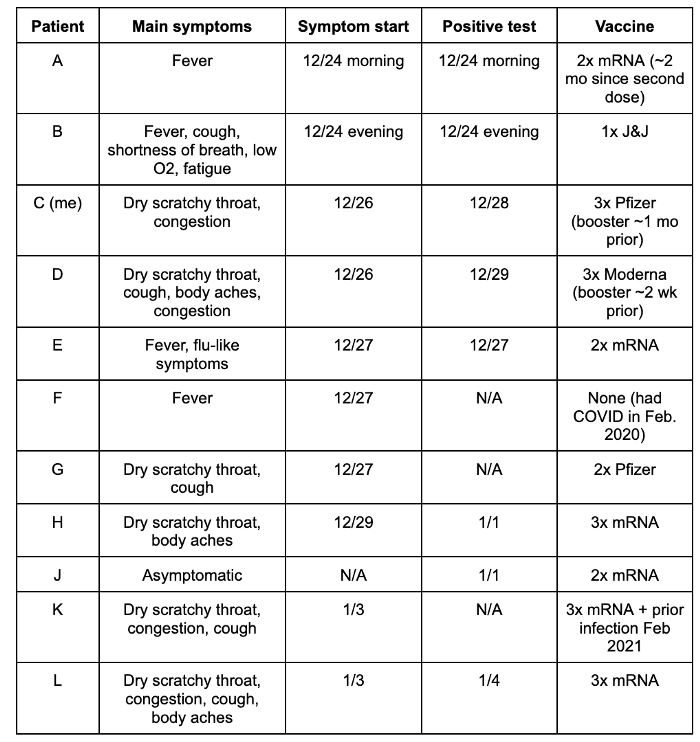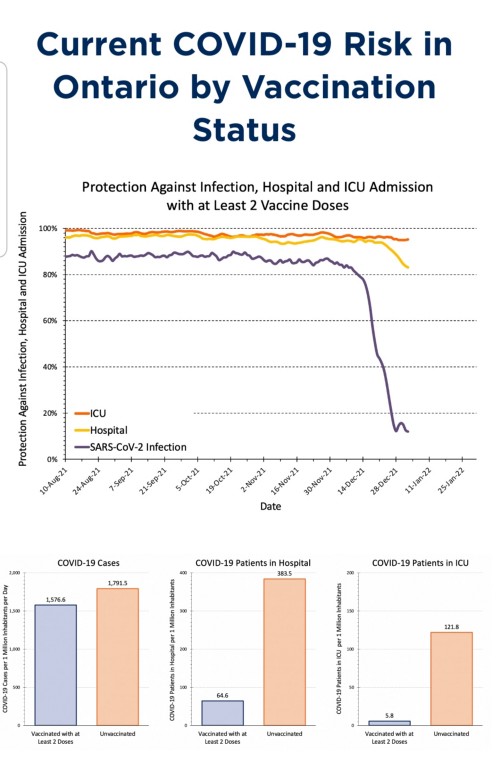COVID made a rude and unexpected appearance at our Christmas celebration this year, most likely due to the immune evasive omicron variant.
All I want for Christmas is a rapid antigen test
I first heard about the omicron variant the day after I got my booster, in late November. At the time I thought the panic was premature, considering the (lack of) data on its transmissibility, virulence, etc. Fast forward one month and I found myself traveling by car across state lines for Christmas, feeling excited to see family and experiencing what I now realize was a false sense of security that my booster shot would act like an impenetrable force field to prevent infection. I did not realize how incredibly contagious and prevalent the omicron variant is and felt confident that the rapid antigen tests I brought along would prevent an outbreak at our gathering. I didn’t have enough for everyone to test ahead of time, but one person had a potential exposure a few days prior, so we tested them and were relieved to see a negative result. I decided we would reserve the remaining tests in case anyone started to develop symptoms. We all got together on Christmas Eve Eve without masks and had a lovely time eating delicious food and playing games. But on the morning of Christmas Eve, we had our first fever and positive test (and this person did not have a known exposure). Again, we didn’t have enough tests for everyone so we (well most of us) masked up and waited to see if and when the next case would pop up. It wouldn’t be long– by evening we had our second fever and positive test. On Christmas morning we started calling every open pharmacy in the area to find more rapid tests so we could at least try to get ahead of it. We managed to find them in stock at a nearby Walgreens and bought enough tests for everyone plus extra in case new symptoms started. On Christmas the rest of us tested negative, but that would change. My husband and I had a flight to Florida the next day (12/26) to see my side of the family, and we were very worried we either wouldn’t be able to go due to a positive test or that we would bring COVID with us unknowingly. On the morning of our flight, we both woke up with dry, scratchy throats but tested negative. We didn’t realize at the time that a scratchy throat is a symptom of COVID in vaccinated people, but I did warn my parents that we could test positive while staying with them. They encouraged us to come anyway because they’re boosted and had an isolation plan if necessary. I double masked on the flight with a surgical mask over my KN95 and hoped for the best.

The day after our arrival in FL we again tested negative, however we decided to wear masks indoors at all times to be safe. The dry, scratchy throats persisted. On the morning of 12/28, my third day of the dry scratchy throat and first day of nasal congestion, my rapid test was screaming positive. Even though the test had a 30 minute incubation time, the band showed up instantly. I was a walking virus factory. My husband’s test was negative but we knew it was just a matter of time. We spent the day outside to avoid infecting everyone else, wore masks inside at all times and ate separately from the others. On the morning of 12/29, my husband started developing congestion, cough, and body aches and tested positive. Again we spent the day outside. Florida is a nice place to recover from mild COVID, incidentally. As I publish this, it’s been ~12 days since we were first exposed, 9 days since our symptoms began, ~7 days since our first positive tests, and our symptoms are almost completely resolved. However, we tested again last night and were still positive. This wouldn’t be surprising if we had done PCR tests, which can be positive for weeks after recovery due to residual viral RNA. But it is somewhat surprising for antigen tests since they recognize a viral protein, and our positive results suggests actively replicating virus is still present (and that we’re still contagious). As of today, 11/16 of our group had likely or confirmed COVID (see table below). Those who have not yet developed symptoms were vaccinated with an mRNA vaccine 2x, 3x, or 3x plus prior infection. A pattern I noticed is that people who received a booster either didn’t get sick at all or at worst developed cold symptoms. Those who were vaccinated but not boosted were more likely to get a fever but some never developed symptoms beyond a dry scratchy throat. I also noticed that boosted individuals tested positive 2–3 days after symptoms began while non-boosted individuals tested positive on the day symptoms started.

How TF did this happen?
Have vaccines failed us? I would argue no! First of all, these vaccines were tested against the original virus, not the more recent variants, and they worked very well in that context. Second, the way the clinical trials were designed demonstrated efficacy against symptomatic disease, not infection and transmission. I think we all had high hopes that the vaccines would stop infection and spread, and they did a pretty good job of that against the original virus and some of the earlier variants, but things have changed now that omicron is here. Third, vaccination is still highly effective at preventing severe illness.

I suspect that our breakthrough cases were caused by the omicron variant, although this can only be confirmed by PCR and sequencing. Omicron has 36 mutations in the spike gene that are predicted to enhance binding to its receptor on human cells and reduce the binding of neutralizing antibodies. In fact a paper published in Nature this weekend demonstrates that omicron deftly evades neutralizing antibodies from previously infected individuals and those who are double vaccinated, while antibodies from those who have been exposed to the spike protein 3 or 4 times (booster +/- infection) maintained their ability to neutralize omicron, but at a reduced level compared to previous variants. Although the vaccines seem to have difficulty preventing infection by omicron, it looks like they still prevent severe disease, and it could be due to T cells. A recent preprint demonstrates that T cells from individuals with prior infection or vaccination with J&J or Pfizer maintain their ability to respond to the omicron spike protein. Neutralizing antibodies are one of the first lines of defense against COVID infection, but if they fail T cells can kill infected cells and prevent the disease from progressing. The bottom line is, while vaccination may not fully protect you from omicron infection, it still does an excellent job of preventing serious illness, especially if you get a booster. So what should we do as the omicron wave crashes over us for the next month or so? The best thing you can do to protect yourself is to get vaccinated and boosted. If you’ve already done that, it’s time to upgrade your mask to a KF94, KN95 or N95. Surgical masks and cloth masks probably aren’t going to cut it anymore. Use rapid antigen tests right before gatherings if you can find them. I’ve found this website handy for finding tests in stock online. Hopefully they’ll become more accessible in the next few weeks. Keep in mind that there is little room for error with omicron and you’re much more likely to catch it compared to previous variants, vaccinated or not. Consider your acceptable level of risk and make smart choices. Stay healthy everyone!
By Nicole Aiello, PhD
Reposted with permission from: https://medium.com/@nicolemaiello/a-very-covid-christmas-6a9096a3c1a8